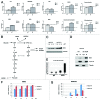Loss of Notch1-dependent p21(Waf1/Cip1) expression influences the Notch1 outcome in tumorigenesis
- PMID: 24801890
- PMCID: PMC4111696
- DOI: 10.4161/cc.29079
Loss of Notch1-dependent p21(Waf1/Cip1) expression influences the Notch1 outcome in tumorigenesis
Abstract
Notch signaling plays a complex role in carcinogenesis, and its signaling pathway has both tumor-suppressor and oncogenic components. In this study we investigated the effects of reactive oxygen species (ROS) on Notch1 signaling outcome in keratinocyte biology. We demonstrate that Notch1 function contributes to the arsenic-induced keratinocyte transformation. We found that acute exposure to arsenite increases oxidative stress and inhibits proliferation of keratinocyte cells by upregulation of p21(waf1/Cip1). The necessity of p21(waf1/Cip1) for arsenite-induced cell death was demonstrated by targeted downregulation of p21(waf1/Cip1) by using RNA interference. We further demonstrated that on acute exposure to arsenite, p21(waf1/Cip1) is upregulated and Notch1 downmodulated, whereas on chronic exposure to arsenite, malignant progression of arsenite-treated keratinocytes cells was accompanied by regained expression and activity of Notch1. Notch1 activity in arsenite-transformed keratinocytes inhibits arsenite-induced upregulation of p21(waf1/Cip1) by sustaining c-myc expression. We further demonstrated that c-myc collaborates with Nrf2, a key regulator for the maintenance of redox homeostasis, to promote metabolic activities that support cell proliferation and cytoprotection. Therefore, Notch1-mediated repression of p21(waf1/Cip1) expression results in the inhibition of cell death and keratinocytes transformation. Our results not only demonstrate that sustained Notch1 expression is at least one key event implicated in the arsenite human skin carcinogenic effect, but also may provide mechanistic insights into the molecular aspects that determine whether Notch signaling will be either oncogenic or tumor suppressive.
Keywords: Notch; Nrf2; metabolism; p21.
Figures







Similar articles
-
Suppression of p53 and p21CIP1/WAF1 reduces arsenite-induced aneuploidy.Chem Res Toxicol. 2010 Feb 15;23(2):357-64. doi: 10.1021/tx900353v. Chem Res Toxicol. 2010. PMID: 20000476 Free PMC article.
-
PLK1 targets NOTCH1 during DNA damage and mitotic progression.J Biol Chem. 2019 Nov 22;294(47):17941-17950. doi: 10.1074/jbc.RA119.009881. Epub 2019 Oct 9. J Biol Chem. 2019. PMID: 31597699 Free PMC article.
-
p21WAF1/Cip1 is a negative transcriptional regulator of Wnt4 expression downstream of Notch1 activation.Genes Dev. 2005 Jun 15;19(12):1485-95. doi: 10.1101/gad.341405. Genes Dev. 2005. PMID: 15964998 Free PMC article.
-
p21Waf1/Cip1: its paradoxical effect in the regulation of breast cancer.Breast Cancer. 2019 Mar;26(2):131-137. doi: 10.1007/s12282-018-0913-1. Epub 2018 Sep 25. Breast Cancer. 2019. PMID: 30255294 Review.
-
Therapeutic targeting of NOTCH1 signaling in T-cell acute lymphoblastic leukemia.Clin Lymphoma Myeloma. 2009;9 Suppl 3(Suppl 3):S205-10. doi: 10.3816/CLM.2009.s.013. Clin Lymphoma Myeloma. 2009. PMID: 19778842 Free PMC article. Review.
Cited by
-
Andrographolide inhibits prostate cancer by targeting cell cycle regulators, CXCR3 and CXCR7 chemokine receptors.Cell Cycle. 2016;15(6):819-26. doi: 10.1080/15384101.2016.1148836. Cell Cycle. 2016. PMID: 27029529 Free PMC article.
-
Mesenchymal Stem/Progenitor Cells: The Prospect of Human Clinical Translation.Stem Cells Int. 2020 Aug 11;2020:8837654. doi: 10.1155/2020/8837654. eCollection 2020. Stem Cells Int. 2020. PMID: 33953753 Free PMC article. Review.
-
Functional cooperation between ASK1 and p21Waf1/Cip1 in the balance of cell-cycle arrest, cell death and tumorigenesis of stressed keratinocytes.Cell Death Discov. 2021 Apr 12;7(1):75. doi: 10.1038/s41420-021-00459-3. Cell Death Discov. 2021. PMID: 33846306 Free PMC article.
-
Arsenic-exposed Keratinocytes Exhibit Differential microRNAs Expression Profile; Potential Implication of miR-21, miR-200a and miR-141 in Melanoma Pathway.Clin Cancer Drugs. 2015;2(2):138-147. doi: 10.2174/2212697X02666150629174704. Clin Cancer Drugs. 2015. PMID: 27054085 Free PMC article.
-
Notch3 contributes to T-cell leukemia growth via regulation of the unfolded protein response.Oncogenesis. 2020 Oct 18;9(10):93. doi: 10.1038/s41389-020-00279-7. Oncogenesis. 2020. PMID: 33071287 Free PMC article.
References
-
- Mazzone M, Selfors LM, Albeck J, Overholtzer M, Sale S, Carroll DL, Pandya D, Lu Y, Mills GB, Aster JC, et al. Dose-dependent induction of distinct phenotypic responses to Notch pathway activation in mammary epithelial cells. Proc Natl Acad Sci U S A. 2010;107:5012–7. doi: 10.1073/pnas.1000896107. - DOI - PMC - PubMed
-
- Talora C, Cialfi S, Segatto O, Morrone S, Kim Choi J, Frati L, Paolo Dotto G, Gulino A, Screpanti I. Constitutively active Notch1 induces growth arrest of HPV-positive cervical cancer cells via separate signaling pathways. Exp Cell Res. 2005;305:343–54. doi: 10.1016/j.yexcr.2005.01.015. - DOI - PubMed
MeSH terms
Substances
LinkOut - more resources
Full Text Sources
Other Literature Sources
